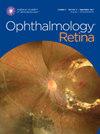Clinical Evaluation of a Novel CRISPR-Cas12a-Based RID-MyC Assay for the Diagnosis of Fungal Endophthalmitis
IF 4.4
Q1 OPHTHALMOLOGY
引用次数: 0
Abstract
Objective
This study evaluated the RID-MyC (Rapid Identification of Mycoses using clustered regularly interspaced short palindromic repeats [CRISPR]) assay, a CRISPR/Cas12a-based diagnostic tool, for its efficacy in diagnosing fungal endophthalmitis (FE) compared with panfungal polymerase chain reaction (PCR) and culture methods.
Design
A comparative cross-sectional study assessing the performance of the RID-MyC assay against established diagnostic modalities for FE.
Subjects
The study included 133 intraocular samples from 117 patients with suspected microbial endophthalmitis.
Methods
The study compared the sensitivity, specificity, positive predictive value, and negative predictive value of the RID-MyC assay against panfungal PCR and culture. The limit of detection for Aspergillus flavus and Candida albicans was determined for both RID-MyC and panfungal PCR across 3 different media: nuclease-free water, aqueous humor, and vitreous humor. Discrepancy analysis was conducted for discordant results, incorporating clinical outcomes and responses to antifungal treatment.
Main Outcome Measures
The study primarily assessed the sensitivity, specificity, positive predictive value, and negative predictive value for clinical samples. Time to diagnosis was also evaluated.
Results
The RID-MyC assay demonstrated a sensitivity of 88.24% (95% confidence interval [CI], 63.56%–98.54%) and specificity of 93.1% (95% CI, 86.86%–96.98%), with positive predictive value and negative predictive value of 65.22% (95% CI, 48.45%–78.91%) and 98.18% (95% CI, 93.62%–99.50%), respectively. Discrepancy analysis enhanced sensitivity to 90.48% (95% CI, 69.62%–98.83%) and specificity to 96.43% (95% CI, 91.11%–99.02%). The RID-MyC assay was 10- to 1000-fold more sensitive than panfungal PCR in detecting A. flavus and C. albicans in intraocular specimens. The time to diagnosis with the RID-MyC assay was consistently <2 hours.
Conclusions
The RID-MyC assay may advance the rapid and precise diagnosis of FE, with possible relevance to other invasive fungal conditions.
Financial Disclosure(s)
Proprietary or commercial disclosure may be found in the Footnotes and Disclosures at the end of this article.
基于 CRISPR-Cas12a 的新型 RID-MyC 检测法用于眼底真菌病诊断的临床评估。
研究目的本研究评估了基于CRISPR/Cas12a的诊断工具RID-MyC(Rapid Identification of Mycoses using CRISPR)测定在诊断真菌性眼内炎(FE)方面的有效性,并将其与泛真菌PCR和培养方法进行了比较:设计:一项横断面比较研究,评估 RID-MyC 检测法与现有 FE 诊断方法的性能:方法:比较 RID-MyC 检测法和现有 FE 诊断方法的灵敏度、特异性和准确性:该研究比较了 RID-MyC 检测法与泛真菌 PCR 和培养法的灵敏度、特异性、阳性预测值 (PPV) 和阴性预测值 (NPV)。研究测定了 RID-MyC 和泛真菌 PCR 在三种不同培养基(无核酸酶水 (NFW)、房水 (AH) 和玻璃体液 (VH))上对黄曲霉和白色念珠菌的检测限 (LoD)。对不一致的结果进行差异分析,并结合临床结果和对抗真菌治疗的反应:研究主要评估了临床样本的敏感性、特异性、PPV 和 NPV。还评估了诊断时间:RID-MyC测定的灵敏度为88.24%(CI:63.56%至98.54%),特异性为93.1%(CI:86.86%至96.98%),PPV和NPV分别为65.22%(CI:48.45%至78.91%)和98.18%(CI:93.62%至99.50%)。差异分析将灵敏度提高到 90.48%(CI:69.62% 至 98.83%),特异性提高到 96.43%(CI:91.11% 至 99.02%)。在检测眼内标本中的黄曲霉菌和白色念珠菌时,RID-MyC 检测法的灵敏度是泛真菌 PCR 的 10 到 1000 倍。RID-MyC测定的诊断时间始终在两小时以内:结论:RID-MyC 检测法可促进对 FE 的快速、精确诊断,并可能与其他侵袭性真菌疾病相关。
本文章由计算机程序翻译,如有差异,请以英文原文为准。
求助全文
约1分钟内获得全文
求助全文

 求助内容:
求助内容: 应助结果提醒方式:
应助结果提醒方式:


